In today’s digital world, images are essential for websites, social media, and online communication. However, high-resolution photos often come with large file sizes (measured in megabytes or MB), which can significantly slow down website loading times and consume excessive bandwidth. This article will guide you through effective methods to reduce the MB size of your photos without compromising too much on visual quality. Understanding how to compress images is crucial for website performance, storage efficiency, and faster sharing.
Understanding Image File Formats for Size Reduction
Before diving into compression techniques, it’s important to understand the common image file formats and how they impact file size. The three primary formats you’ll encounter for web images are JPG, PNG, and GIF. Each uses different compression methods and is suited for different types of images.
JPG (or JPEG)
JPG is the most widely used format for photographs and images with complex colors and gradients. It uses “lossy” compression, which means some image data is discarded during the compression process to reduce file size. The level of compression can be adjusted, allowing you to balance file size and image quality. Higher compression results in smaller files but potentially more noticeable quality loss, while lower compression retains more quality but results in larger files.
PNG
PNG (Portable Network Graphics) is a versatile format that comes in two main types for web use: PNG-8 and PNG-24.
-
PNG-8: Similar to GIF, PNG-8 is best for simple graphics, logos, and images with limited colors (up to 256). It uses “lossless” compression for indexed colors, meaning no image data is lost. PNG-8 generally offers better compression than GIF and also supports transparency.
-
PNG-24: This format is designed for images with many colors, like photographs, and offers lossless compression for full-color images. While it preserves image quality perfectly, PNG-24 files are typically larger than JPGs for photographic content. A key advantage of PNG-24 is its support for alpha transparency, allowing for smooth, variable transparency levels.
GIF
GIF (Graphics Interchange Format) is an older format primarily used for simple animated images and graphics with limited colors (256 colors or less). GIF uses lossless compression, but its color palette limitation means it’s not ideal for photographs or complex images. While GIFs support transparency, PNG-8 generally provides better compression and quality for static images.
Compressing JPG Files: Balancing Quality and Size
JPG compression is controlled by adjusting the “quality” setting when saving or exporting your image from an image editing program. This setting is often represented as a slider, percentage (0-100%), or quality levels (low, medium, high, maximum). The key is to find the lowest quality setting that still provides acceptable visual results for your intended purpose.
A practical approach to finding the optimal JPG quality is to start with a relatively high setting (like 80% or “high” quality) and gradually reduce it while visually inspecting the image. Observe the image for any signs of artifacts or quality degradation. When you notice unacceptable quality loss, revert to the previous, better-looking setting.
Consider the purpose of the image. For a detailed botanical encyclopedia, high quality is crucial to show fine details. For a casual social media post, lower quality might be perfectly acceptable.
Let’s examine the effect of different JPG quality settings on file size and visual quality using a sample flower photo.
100% Quality: 103 KB file size. This is rarely necessary for web use and results in a larger file size without significant visual benefit over slightly lower settings.
 Daylily flower and buds at 100% JPG quality
Daylily flower and buds at 100% JPG quality
80% Quality: 48 KB file size. Visually, very difficult to distinguish from the 100% setting, yet almost half the file size.
 Daylily flower and buds at 80% JPG quality
Daylily flower and buds at 80% JPG quality
60% Quality: 28 KB file size. Most viewers would likely not notice any quality difference from the 100% version. The file is now a quarter of the original size, leading to significantly faster loading.
 Daylily flower and buds at 60% JPG quality
Daylily flower and buds at 60% JPG quality
40% Quality: 17 KB file size. Still acceptable for many general web uses, and the file size is reduced dramatically, loading five times faster than the 100% quality image.
 Daylily flower and buds at 40% JPG quality
Daylily flower and buds at 40% JPG quality
20% Quality: 12 KB file size. Quality degradation becomes noticeable with visible artifacts.
 Daylily flower and buds at 20% JPG quality
Daylily flower and buds at 20% JPG quality
0% Quality: 7 KB file size. Severe blockiness and quality loss are very apparent, making the image unsuitable for most purposes.
 Daylily flower and buds at 0% JPG quality
Daylily flower and buds at 0% JPG quality
Sample flower image from FCIT’s plant photo collection on ClipPix ETC.
Blurring for Further JPG Compression
Another effective technique to reduce JPG file size is to subtly blur the image before compression. Images with fewer sharp details and edges compress more efficiently in the JPG format. This is particularly useful for background images or when slight blurring is visually acceptable.
Consider blurring only specific parts of an image. For example, blurring a busy background can reduce file size while keeping the main subject sharp and in focus.
Let’s compare a sharp image with a version where the background is blurred:
Sharp Image (60% JPG Quality): 77 KB file size.
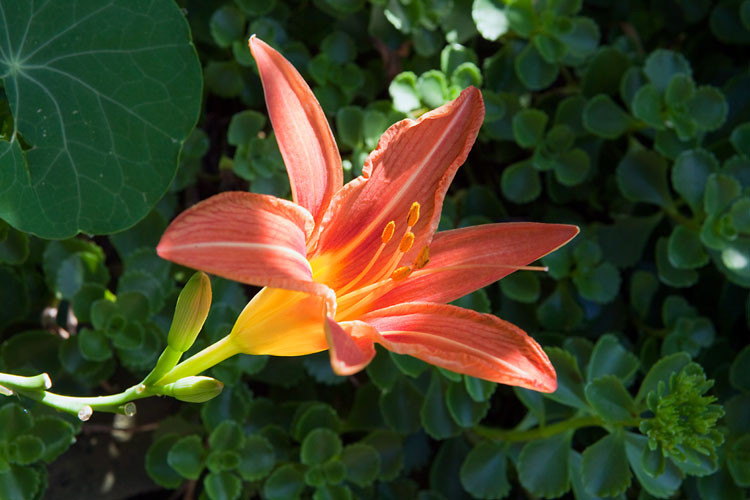 Day lily flower with a sharp background
Day lily flower with a sharp background
Background Blurred Image (60% JPG Quality): 54 KB file size. By blurring the background, the file size is reduced by approximately 30% at the same quality setting, leading to faster loading times and a more visually appealing image with focus on the flower.
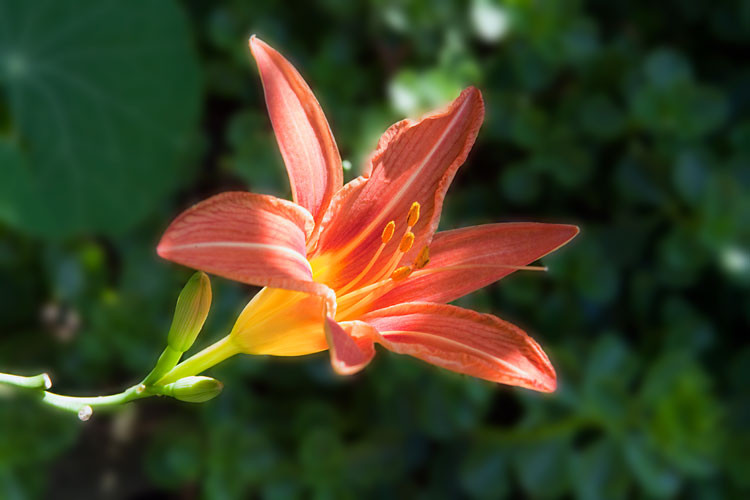 Day lily flower with a blurred background
Day lily flower with a blurred background
Important Note on JPGs: JPG is a lossy format. Each time you save a JPG, you lose some image quality. Always preserve your original image in a lossless format like TIFF or PSD. Export to JPG only for the final web-ready version. Avoid re-saving a JPG multiple times, as this will progressively degrade the image quality.
Compressing GIF Files: Color Reduction and Dithering
GIF compression primarily revolves around reducing the number of colors in the image. GIFs are limited to a maximum of 256 colors. Reducing the color palette significantly reduces file size. Aim for color counts close to powers of 2 (256, 128, 64, 32, 16, 8, 4, or 2) for optimal compression. For instance, reducing a 33-color image to 32 colors will yield a larger file size reduction than going from 32 to 31 colors.
When saving as GIF, you’ll typically have options to select the number of colors, dither pattern, and transparency.
- Color Reduction: Choose the lowest number of colors that maintains acceptable image quality.
- Dithering: If your image contains gradients and you notice “banding” (stepped color transitions), dithering can help. Dithering introduces a pattern of pixels to simulate smoother color transitions. “Diffusion” dithering is often the most effective.
- Transparency: Select “transparency” if your GIF needs transparent areas.
Settings like “Web snap” and “Matte” are generally less relevant for modern web use and can often be ignored.
GIF remains a popular choice for simple animations.
 Animated dancing robot GIF example
Animated dancing robot GIF example
Animated robot graphic from FCIT’s robot illustrations collection on the TIM website.
Compressing PNG Files: Choosing PNG-8 or PNG-24
PNG offers two main compression options for web graphics: PNG-8 and PNG-24, each suited for different image types.
PNG-8 Compression
PNG-8 is similar to GIF and best for graphics with limited colors and solid areas, such as logos and illustrations. Like GIF, PNG-8 uses indexed colors (up to 256) and lossless compression, but generally achieves smaller file sizes than GIF for similar images.
When exporting as PNG-8, you’ll encounter similar settings to GIF: color reduction, dithering, and transparency. Choose the appropriate number of colors and dithering if needed. PNG-8 typically provides better compression than GIF with comparable visual quality.
Let’s compare GIF and PNG-8 for the same cartoon image:
Cartoon saved as GIF (32 colors): 13.6 KB file size.
 Cartoon graphic saved as GIF format
Cartoon graphic saved as GIF format
Cartoon saved as PNG-8 (32 colors, same settings): 10.2 KB file size. PNG-8 achieves a 25% file size reduction compared to GIF for the same image and settings.
 Cartoon graphic saved as PNG-8 format
Cartoon graphic saved as PNG-8 format
Cartoon graphics from FCIT’s tech cartoons collection on the TIM website.
PNG-24 Compression
PNG-24 is a lossless format ideal for photographs and images requiring full color depth (more than 256 colors). Being lossless, PNG-24 preserves image quality perfectly but results in larger file sizes compared to JPG for photographs.
When exporting as PNG-24, there are typically fewer compression options because it’s a lossless format. The file size can be significantly larger than a JPG for photographic content.
Consider these examples comparing PNG-24 and JPG for a photo of macaws:
Photo saved as PNG-24: 400 KB file size. Relatively large file size due to lossless compression.
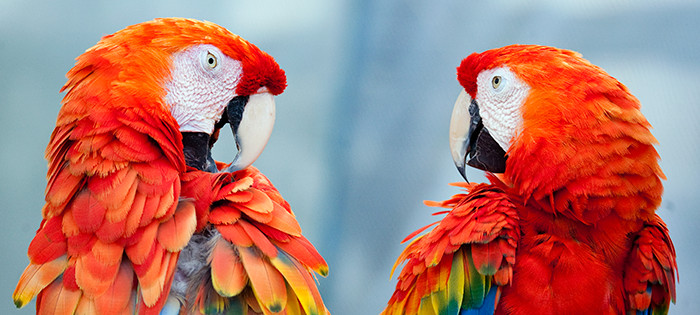 Photo of two macaws saved as PNG-24 format
Photo of two macaws saved as PNG-24 format
Photo saved as JPG (Maximum 100% Quality): 259 KB file size. Smaller than PNG-24, but still larger than necessary for web use.
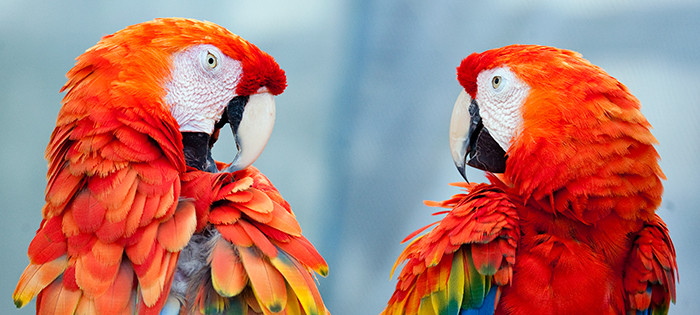 Photo of two macaws saved as JPG at maximum quality
Photo of two macaws saved as JPG at maximum quality
Photo saved as JPG (High 60% Quality): 69 KB file size. Significantly smaller file size with a good balance of quality for web display.
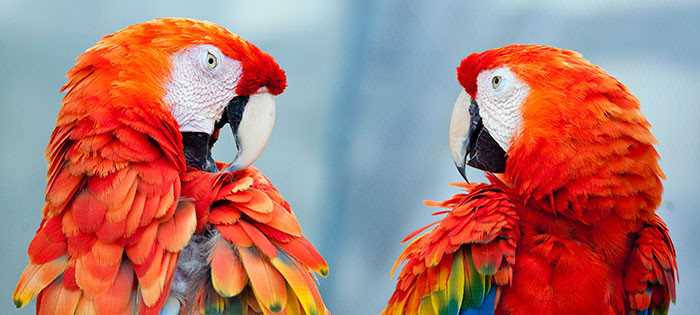 Photo of two macaws saved as JPG at high quality
Photo of two macaws saved as JPG at high quality
Animal photo from FCIT’s animal photo collection on ClipPix ETC.
Why Choose PNG-24 over JPG?
Despite the larger file sizes, PNG-24 is preferable in specific situations:
- Transparency: PNG-24 supports alpha transparency, which is essential for images with smooth transparency effects that JPG cannot handle.
- Lossless Quality: When absolute image quality is paramount and no compression artifacts are acceptable, PNG-24’s lossless nature is crucial.
- Sharp Details: For images with fine lines, text, or screenshots, PNG-24 preserves pixel-level sharpness, avoiding the “smudging” effect that JPG compression can introduce, especially on text.
Conclusion: Optimize Image Size for a Faster Web
Reducing the MB size of your photos is a vital step in optimizing website performance and user experience. By understanding the characteristics of JPG, PNG, and GIF formats and applying appropriate compression techniques, you can significantly reduce file sizes without unacceptable quality loss. Experiment with quality settings, consider blurring for JPGs, reduce color palettes for GIFs and PNG-8s, and choose PNG-24 when lossless quality or transparency is essential. Implementing these strategies will lead to faster loading websites, improved user engagement, and efficient bandwidth usage.
